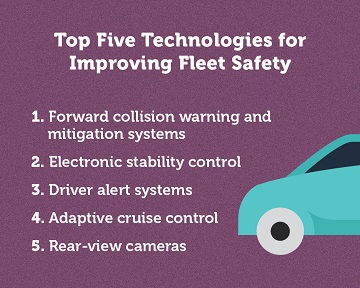- Home
- Loss Control
- Loss Control Insights
- Top 5 Technologies for Improving Fleet Safety
Chad Veach, Engineering Services Manager
Technology is changing everything, from how we communicate to how we’re entertained. It’s also rapidly changing the nature of fleet safety. Car and truck manufacturers continue to invest in technology to make vehicles safer. Fleet owners should take full advantage of these advances that have been tested and proven to reduce the likelihood of accidents. When it comes time to upgrade your vehicles, make sure you select vehicles equipped with these technologies. Although technologies will continue to evolve, here’s the top 5 currently on the market.
1. Forward Collision Warning and Mitigation Systems
According to the National Safety Council, rear-end collisions account for approximately 28% of all collisions, with driver inattention identified as a contributing factor in over 60% of these crashes. Forward collision warning and mitigation devices use radar, sensors and cameras to avoid or reduce the severity of a frontal collision. Some devices simply warn the driver of an impending collision, while others use emergency braking or brake assist to further reduce the likelihood of a collision. The AAA Foundation for Traffic Safety reports that cars equipped with forward collision warning systems can reduce rear-end collisions by about 10%. The Foundation also cites insurance studies showing owners of cars equipped with forward collision warning and mitigation systems have lower claim rates than owners who do not employ these technologies.
2. Electronic Stability Control
“Electronic stability control is the single most important advancement in auto safety since the development of the seatbelt,” said David Champion, senior director of automotive testing for Consumer Reports. So it’s no surprise the National Highway Traffic Safety Administration (NHTSA) has required that all passenger vehicles be equipped with this safety feature since 2012. Electronic stability control systems continuously monitor tire movement and steering wheel activity to sense a loss of traction or slippage. In these situations, the system can reduce engine power, apply brakes independently to each wheel and correct tire suspension much faster than the driver could. These systems are particularly helpful in managing unexpected events or when driving on wet or icy roadways. These systems are highly effective and could help prevent up to 800,000 single-vehicle crashes per year (48%). Fatal crashes could be reduced 40-56%.
3. Driver Alert Systems
NHTSA conservatively estimates that 100,000 crashes are directly caused by driver fatigue each year. As a result, many companies use a variety of driver alert systems to detect when drivers get too drowsy to drive safely. These include:
- Lane and road departure warning systems
- Steering wheels and hats equipped with technologies to recognize drowsiness
- Driver-facing video devices and apps that gauge the user’s level of fatigue based on factors such as age, weight and average amount of sleep a night
Note: Many of these technologies are new to the market and have not undergone extensive testing to document their effectiveness.
4. Adaptive Cruise Control
Cruise control has been around since the late 1950s, but adaptive cruise control is a relatively new safety feature. Adaptive cruise control senses where the vehicle in front of you is in relation to your own vehicle, and slows down or speeds up your vehicle to maintain a safe following distance. According to the AAA Foundation for Traffic Safety, these systems may help prevent 13,000 crashes per year. According to a survey of drivers using the technology, nearly half said the system helps relieve stress and about a third said the system made them a safer driver.
5. Rear-View Cameras
According to the U.S. Department of Transportation, rear-view cameras will become standard equipment in passenger vehicles by 2018. These devices can help fleet drivers see the back of the vehicle and are especially helpful in fleets with light-duty trucks. However, AAA still recommends drivers walk behind their vehicle to visually confirm that there are no obstacles and use the rear-view camera to confirm that nothing has entered the area immediately behind the vehicle since the driver’s walk-through inspection. When combined with blind spot warning and cross traffic alert technology, rear-view cameras complement the driver’s skill to better assess all blind spots.
Let’s Not Forget Driver Training
These 5 technologies do not replace the need for a well-trained, alert driver who is always using safe driving practices. Ongoing driver training should include information on safe vehicle operation, as well as discussing these technologies if your organization chooses to use them. For a variety of online fleet and driver safety resources, visit our Fleet and Driver Safety page on the EMC website.
Get in touch
Need help? We’re here for you! Whether you have questions or need personalized assistance, your local office is ready to support you.
Loss Control Insights
Stay informed with the latest news and receive actionable safety tips, all carefully curated by our team of experts.
